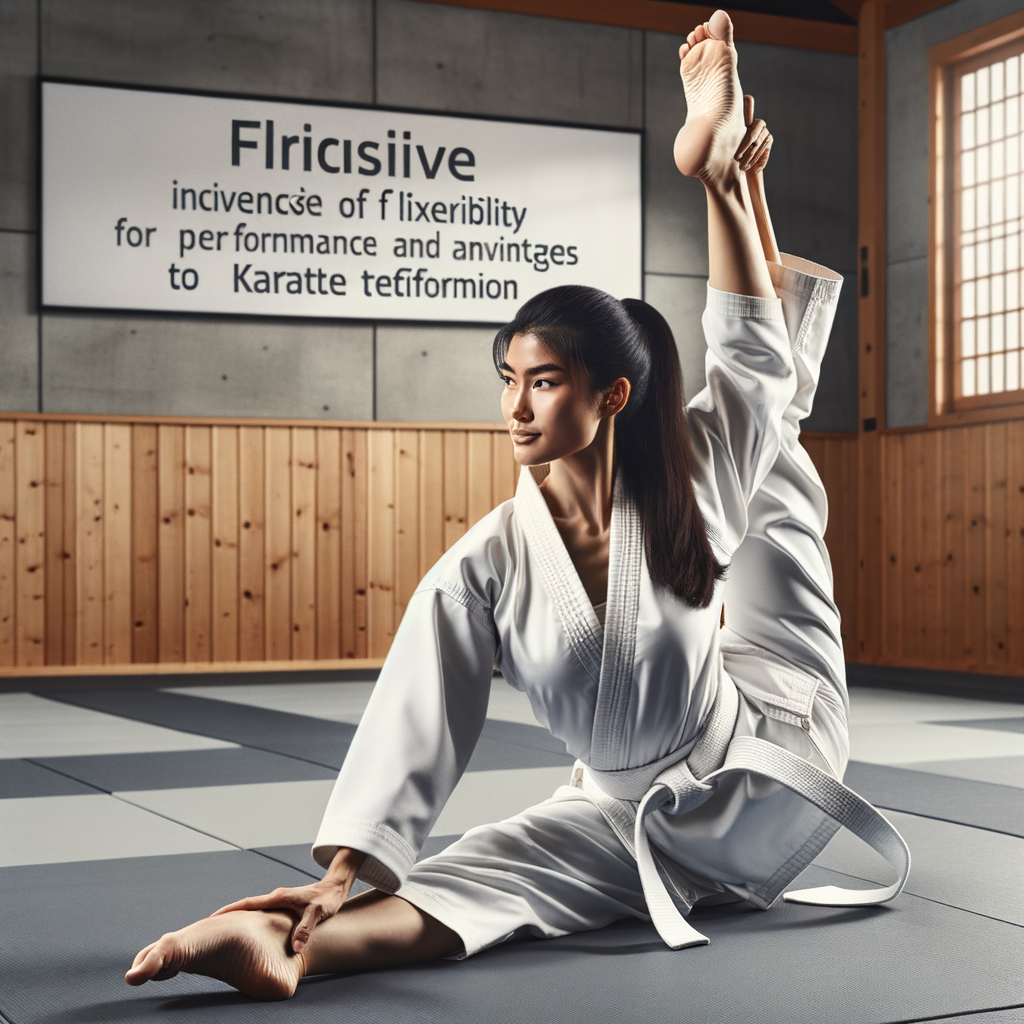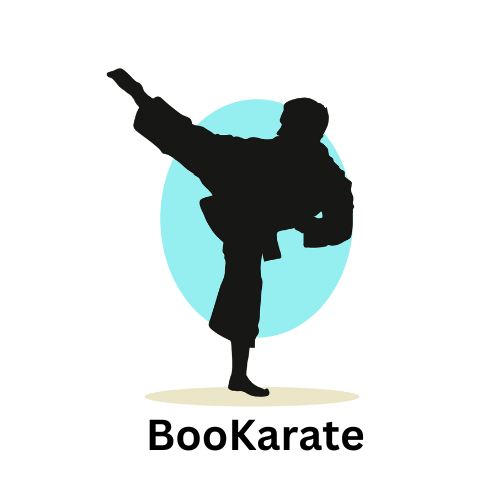
Introduction to Flexibility in Martial Arts
Flexibility is a crucial aspect of martial arts that often goes unnoticed. It’s not just about high kicks and impressive moves; flexibility plays a significant role in the overall performance and health of a martial artist. In this section, we will delve into the concept of flexibility and its importance in martial arts.
- Understanding the concept of flexibility
- Importance of flexibility in martial arts
Flexibility refers to the range of motion in a joint or series of joints, and length in muscles that cross the joints. It’s about how far we can bend, twist and reach. In martial arts, flexibility is not just about being able to perform high kicks or splits, but it’s also about improving your overall mobility, balance, and injury prevention.
Flexibility is essential in martial arts for several reasons. First, it improves your performance by allowing you to execute techniques more efficiently and effectively. For instance, a flexible martial artist can deliver high kicks with ease, which can be a decisive factor in a match. Second, flexibility enhances your range of motion, which can help you avoid injuries. A flexible body is less likely to get injured as it can withstand more physical stress. Lastly, flexibility aids in recovery. After a rigorous training session or a match, a flexible body recovers faster as it can handle the stress better.
In conclusion, flexibility is a vital aspect of martial arts that contributes to better performance, injury prevention, and faster recovery. Therefore, it’s essential for martial artists to incorporate flexibility training into their routine.
Importance of Flexibility in Karate
Flexibility is a crucial aspect of karate, a martial art form that requires a combination of strength, precision, and fluidity. It plays a significant role in enhancing performance and reducing the risk of injuries. Let’s delve into the importance of flexibility in karate.
- Benefits of Flexibility in Karate
- Role of Flexibility in Karate Techniques
Flexibility offers numerous benefits in the practice of karate. It improves the range of motion, allowing karate practitioners to execute high kicks and swift movements with ease. It also enhances muscle coordination, which is vital for maintaining balance during complex karate techniques.
Moreover, flexibility aids in injury prevention. By increasing the elasticity of muscles and tendons, it reduces the risk of strains and sprains. A flexible body can withstand the physical demands of karate, making it easier for practitioners to perform at their best without worrying about potential injuries.
Flexibility plays a pivotal role in executing karate techniques effectively. High kicks, for instance, require a good degree of flexibility in the hamstrings and hip flexors. Similarly, stances like the front stance (Zenkutsu-dachi) and the back stance (Kokutsu-dachi) demand flexibility in the legs and lower body.
Furthermore, flexibility enhances speed and agility, which are essential for performing quick, sharp movements in karate. A flexible body can move more fluidly, allowing karate practitioners to execute techniques with greater precision and power.
In conclusion, flexibility is not just an added advantage in karate; it’s a necessity. It enhances performance, prevents injuries, and plays a crucial role in the execution of karate techniques. Therefore, incorporating flexibility training into your karate regimen can significantly improve your skills and overall performance.
Karate Training Techniques
Learning karate is not just about fighting. It’s about discipline, focus, and mastering a set of techniques. Let’s explore some basic karate training techniques that every beginner should know.
Basic Karate Training Techniques
There are three fundamental techniques in karate: stances, punches, and kicks. These are the building blocks of karate, and mastering them is essential for any karateka (karate practitioner).
- Stances
- Punches
- Kicks
The stance is the foundation of all karate techniques. It provides balance, stability, and power. There are many different stances in karate, but beginners usually start with the front stance (zenkutsu-dachi) and the horse stance (kiba-dachi).
Punching is a fundamental part of karate. The straight punch (choku-zuki) is the most basic punch in karate. It’s a direct punch to the opponent’s body, delivered from the shoulder with the fist rotating at the end.
Kicking is another essential technique in karate. The front kick (mae-geri) is one of the first kicks students learn. It’s a straightforward kick delivered with the ball of the foot to the opponent’s body.
Remember, karate is not about strength, but technique. Practice these basic techniques regularly, and you will see improvement in your karate skills.
Advanced Karate Training Techniques
As we delve deeper into the world of karate, we encounter advanced training techniques that require a higher level of skill and understanding. These techniques, namely Kata and Kumite, are essential for any karateka aspiring to reach the pinnacle of this martial art. Let’s take a closer look at these techniques.
- Kata
Kata is a series of defensive and offensive moves against imaginary opponents. It is a choreographed pattern that helps a karateka to practice alone while imagining real-life combat situations. Kata is not just about physical movements; it also involves the mind. It’s like a dance where every move has a specific meaning and purpose.
| Benefits of Kata |
|---|
| Improves balance and coordination |
| Enhances focus and concentration |
| Develops understanding of combat techniques |
- Kumite
Kumite, on the other hand, is a sparring exercise where two karatekas face each other in a controlled environment. This technique allows karatekas to apply the moves learned in Kata in a real-life situation. It’s a test of timing, speed, and control. Kumite can be practiced in different ways, from basic to advanced levels, always prioritizing safety.
| Benefits of Kumite |
|---|
| Improves reaction time and speed |
| Enhances understanding of distance and timing |
| Develops real-life self-defense skills |
Both Kata and Kumite are vital for advanced karate training. They complement each other, with Kata providing the foundation of techniques and Kumite allowing their application in real-life scenarios. Remember, practice is key in mastering these advanced techniques. So, keep training and keep improving!
Improving Flexibility for Karate
Flexibility is a key component in karate and other martial arts. It allows for a wider range of motion, better performance, and reduced risk of injury. In this section, we will explore some exercises that can help improve your flexibility for karate.
Karate Flexibility Exercises
There are several exercises that can help improve your flexibility for karate. These exercises can be categorized into three main types: stretching exercises, dynamic flexibility exercises, and static flexibility exercises.
- Stretching exercises: These are the most common type of flexibility exercises. They involve slowly stretching your muscles to increase their length and flexibility. Some common stretching exercises for karate include the hamstring stretch, the hip flexor stretch, and the shoulder stretch. Remember to hold each stretch for at least 30 seconds and to breathe deeply and relax as you stretch.
- Dynamic flexibility exercises: These exercises involve moving parts of your body to increase their range of motion. They can be particularly useful for improving flexibility in the hips and legs, which are crucial for many karate moves. Some examples of dynamic flexibility exercises include leg swings, arm circles, and hip circles.
- Static flexibility exercises: These exercises involve holding a stretch for a prolonged period of time. They can help to increase the length of your muscles and improve your overall flexibility. Some examples of static flexibility exercises include the splits, the butterfly stretch, and the pigeon pose.
Remember, consistency is key when it comes to improving flexibility. Try to incorporate these exercises into your regular karate training routine for the best results.
Karate Training Tips for Flexibility
Flexibility is a crucial aspect of karate training. It not only enhances your performance but also reduces the risk of injuries. Here are some effective tips to improve your flexibility for karate:
- Consistent practice: Consistency is key when it comes to improving flexibility. Regular practice helps to gradually increase the range of motion in your joints and muscles. It’s not about how much time you spend in one session, but how often you practice. A 15-minute daily routine can be more effective than a two-hour session once a week.
- Proper warm-up and cool-down: Never skip your warm-up and cool-down sessions. A proper warm-up prepares your body for the training session, increases your body temperature, and makes your muscles more pliable. Similarly, a cool-down session helps to gradually decrease your heart rate and relax your muscles, reducing the risk of stiffness and muscle soreness.
- Regular rest and recovery: Rest is just as important as training. Your muscles need time to recover and adapt to the new demands you’re placing on them. Make sure to have at least one rest day per week and get plenty of sleep. Remember, it’s during rest that your muscles grow and become more flexible.
By following these tips, you can significantly improve your flexibility for karate. Remember, flexibility is not something you can achieve overnight. It requires patience, consistency, and dedication. So, keep practicing and stay flexible!
Flexibility Training for Karate
Flexibility training is a crucial part of any martial arts training, especially in karate. It can significantly enhance your performance, reduce the risk of injuries, and improve your overall health. Let’s delve into the importance of a flexibility training routine, some examples of exercises, and the benefits of flexibility training for karate.
- Importance of a Flexibility Training Routine
- Examples of Flexibility Training Exercises
- Leg Stretches: These include forward bends, side lunges, and hamstring stretches. They help to increase the flexibility of your legs, which is crucial for high kicks and stances in karate.
- Arm Stretches: These include shoulder stretches, tricep stretches, and wrist stretches. They help to improve the flexibility of your arms, which is important for punches and blocks in karate.
- Back Stretches: These include cat-cow stretches, cobra stretches, and bridge stretches. They help to increase the flexibility of your back, which is essential for maintaining good posture in karate.
- Benefits of Flexibility Training for Karate
Flexibility training is essential for karate practitioners. It helps to increase the range of motion in your joints, which can lead to improved technique and power. Additionally, a good flexibility routine can help to prevent injuries by ensuring your muscles are well-prepared for the demands of karate. According to a study, flexibility training can reduce the risk of injuries by up to 50%.
There are numerous exercises that can help improve your flexibility for karate. Here are a few examples:
Flexibility training offers numerous benefits for karate practitioners. It can help to improve your technique by allowing you to perform high kicks and deep stances with ease. It can also increase your speed and power by enabling your muscles to work more efficiently. Furthermore, flexibility training can enhance your endurance by reducing muscle fatigue. A study showed that karate practitioners who incorporated flexibility training into their routine were able to perform at a higher level for a longer period of time.
In conclusion, flexibility training is an integral part of karate training. It can help to improve your performance, prevent injuries, and enhance your overall health. So, make sure to incorporate a good flexibility routine into your karate training regimen.
Martial Arts Training Importance
Understanding the importance of martial arts training goes beyond the physical. It also provides mental and spiritual benefits that can significantly improve your overall well-being. Let’s delve into each of these aspects.
- Physical Benefits of Martial Arts Training
Martial arts training is an excellent way to keep your body fit and healthy. It improves your flexibility, which is crucial in executing various techniques and avoiding injuries. Regular training also enhances your strength, endurance, and coordination. According to a study by the American Council on Exercise, martial arts can burn up to 500 calories per hour, making it an effective way to maintain a healthy weight.
- Mental Benefits of Martial Arts Training
Training in martial arts is not just about physical strength; it’s also about mental fortitude. It helps improve focus, concentration, and discipline. It teaches you to control your emotions and respond calmly in stressful situations. A study published in the Journal of Pediatric Psychology found that children who practice martial arts show improved attention span and behavioral control.
- Spiritual Benefits of Martial Arts Training
Martial arts is also a spiritual journey. It promotes self-awareness, inner peace, and respect for others. It teaches you to be present in the moment, which can help reduce stress and anxiety. Many martial arts disciplines, like Karate, emphasize the importance of balance between the mind, body, and spirit for overall well-being.
In conclusion, martial arts training offers a holistic approach to health and well-being. It helps you develop physically, mentally, and spiritually, making it a worthwhile pursuit for people of all ages.
Conclusion: Karate Training Flexibility
In this article, we have explored the vital role flexibility plays in karate training. As we conclude, let’s recap the importance of flexibility in karate and highlight the key takeaways on how to improve it.
- Recap of the importance of flexibility in karate:
- Key takeaways on improving flexibility for karate:
Flexibility is a cornerstone of karate training. It enhances your ability to execute high kicks, improves your range of motion, and reduces the risk of injuries. As we have seen in the case studies, karate practitioners with high flexibility levels tend to perform better and have a lower risk of sustaining injuries. Remember, flexibility is not just about stretching; it’s about maintaining a balanced and healthy body.
Improving flexibility for karate involves a combination of dynamic and static stretching exercises. Regular practice and consistency are key. Here are some quick tips: Warm up before stretching, focus on the muscles used most in karate, and remember to breathe correctly during stretches. Also, don’t forget the importance of rest and recovery in maintaining and improving flexibility.
As we conclude, remember that flexibility is not achieved overnight. It requires patience, dedication, and consistent practice. However, the benefits it brings to your karate training are worth the effort. So, keep stretching and keep improving!






